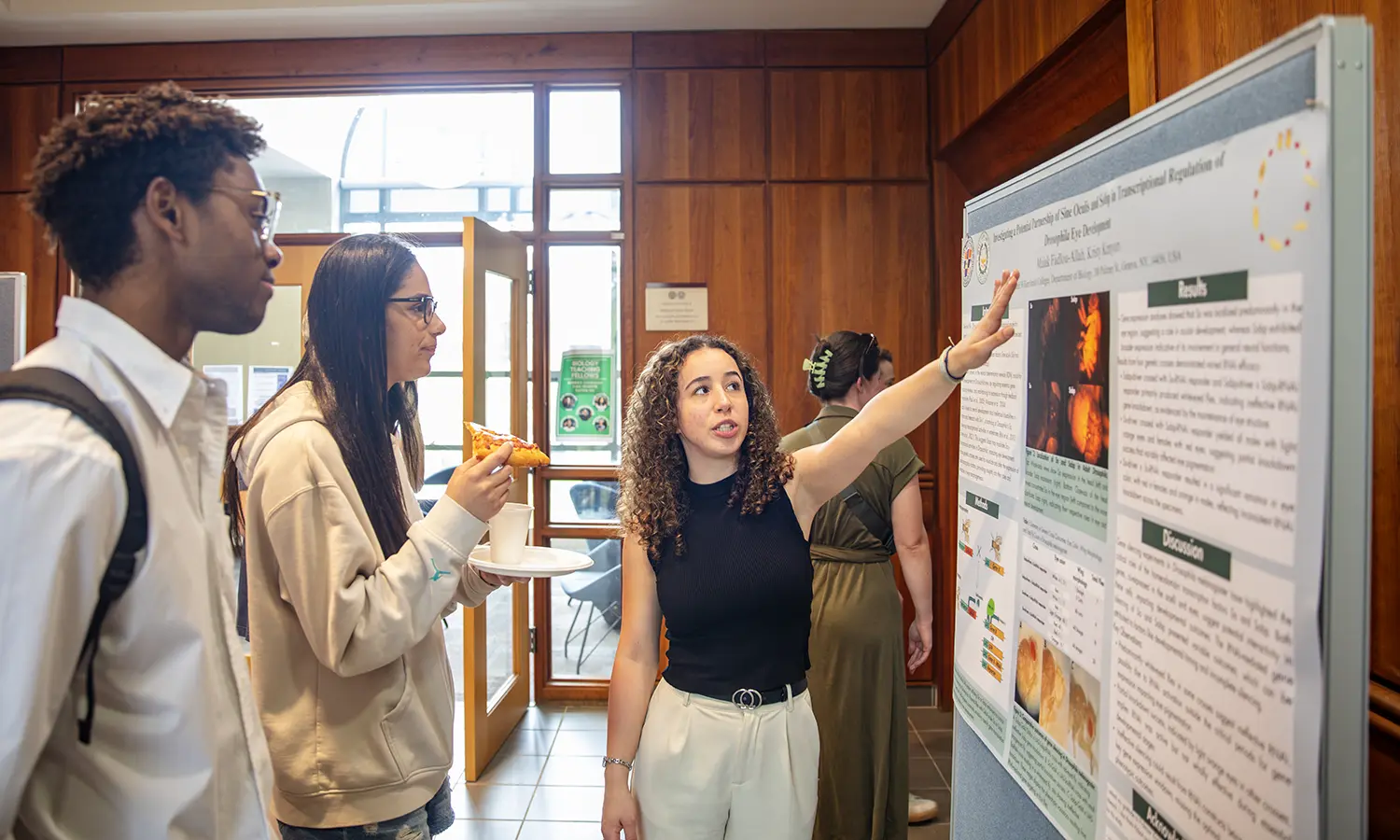Research
UNDERGRADUATE RESEARCH
Malak Fadlou-Allah ’24 presents her research completed under the direction of Professor of Biology Kristy Kenyon to Nicholas Short ’27 and Lina Nour Hassini ’26 in Rosenberg Hall.
Hobart and William Smith students benefit from the HWS’ long and valuable relationship with Cornell’s AgriTech, located right in Geneva. Our students work and study alongside AgriTech scientists during the school year and summer, gaining significant exposure to applied research while making important contributions to experiment station projects.
Students interested in pursuing careers in medicine also have access to clinical internships, skill training and direct patient care experiences through a special partnership with Finger Lakes Health, a local health system with 75 staff physicians and a broad range of primary and specialty services located just one mile from campus.
Here’s a recent sampling of student projects:
- Owen Carolan ’26: Examining the Role of the Sineoculus Binding Protein (SOBP) in the Drosophila Ovary
- Kathryn Crandall ’26 and Lillian Morrell ‘26: Migration Monitoring at Hanley Nature Preserve
- Linnea Darius ’26: Through the Eyes of Lake Trout: Understanding Diet Histories in Seneca Lake using Stable Isotope Analysis
- Lillian Morrell ’26 and Kathryn Crandall ’26: Passerine Bird Banding at Hanley Nature Preserve
- Chuck Watroba ’26 and Aidan Staunton ’26: Biological Evaluation of Indolylfuranones as Potential Anti-Cancer Agents
- Aidan Staunton ’26: Developing a CAM Assay for Anti-Angiogenic Compound Evaluation
- Lindsey Balman '25 and Nataly Vargas '24: Phylogeographic Relationships of Two Eastern North American Milkweeds (Asclepias syriaca and Asclepias tuberosa)
- Kevin Frost '25: Shedding Light on Water Clarity: The Impact of Turbidity on Light-Based Trapping of
- Andrew Painton ’25: Plunged into Darkness: The Impact of a Total Solar Eclipse on Zooplankton Migration in Seneca Lake
- Juliette Pike '25: An Update on Alzheimer's Disease: Moving Away from the Central Dogma
- Victoria Smith '25: Comparison of Round Goby (Neogobius melanostomus) Diet in Seneca and Cayuga Lakes Hemimysis anomala
- Elizabeth Starck ’25: Exploring the Genetics of Polycystic Ovary Syndrome: An Argument for Federal Funding
- Rianna Tomm ’25: The Effects of Multiple Exposures to Anesthesia on Embryo Development
- Marcella Venettozzi ’25 and Delaney Williams ’26: Assessing the Cytotoxicity of Halogenated Compounds.
- Claudia Kalina '23 and Malak Fadlou-Allah '24: Phylogenetic relationships and species boundaries of the temperate North American clade of milkweeds (Asclepias; Apocynaceae).
- Erika Sipos '23 and Deirdre O'Malley '22: Untangling evolutionary relationships within the Parsonsiinae subtribe of Apocynaceae using chloroplast and mitochondrial genomes and rDNA
- Malak Fadlou-Allah ’24: Investigating a Potential Partnership of Sine Oculis and Sobp in Transcriptional Regulation of Drosophila Eye Development.
- Regina Hashim ’24 and Mark Suchewski ’22: Using camera trap data to detect an urban-rural cline in melanism in a widespread mammal
- Molly Dexter ’22: Biological Evaluation of Indole-Substituted Furanone Compounds on Cancer Cells
- Maegan Manning ’22: Determining Antibiotic and Anti-cancer Potential of Small Compounds
- Matt McNulty ’22: Assessing Unique Contact Residues of Chemotaxis-Like Proteins in an Escherichia coli model
- Mark Suchewski ’22: Habitat selection by color morphs of eastern gray squirrels (Sciurus carolinensis) after translocation
- Mackenzie Howie ’21: Testing the Antimicrobial Activity of Indole Compounds
- Meg Quint ’21: The Puzzling Plastomes of Periplocoideae
- Mimi Smith ‘21: Investigating Lake Trout Diet in the Finger Lakes
- Meredith Fennell ’20: Resolving phylogenetic relationships of Apocynoideae (Apocynaceae) using genome skimming
- McKenzie Frazier ’20: The effect of Round Goby on benthic macroinvertebrate lake communities
- Meredith Steinfeldt ’20: Plastome phylogenomics of the common milkweed clade of Asclepias (Apocynaceae)
- Charmaine Chung ’19: Comparison of de novo and reference-guided assembly in the characterization of the chloroplast genome of Gelsemium sempervirens
- Susan Garber ’19: Identifying the critical amino acids required for protein binding between Sobp and Sine oculis, a transcription factor required for the formation of the Drosophila eye
- Andrew Herrmann ’19: Assessing anti-cancer potential of newly synthesized staurosporine analogs containing a 3-furan-2-one group
- Gurpawan Kang ’19 and Minna Kim ’19: Evaluating the effects of Xyzistatin and Vorinostat on U937 cells
- Elizabeth McAnaney ’19: Macroinvertebrate Communities Across Three Sites in Castle Creek
- Marissa McFadden ’19: Synthesis and Reactions of Tetramic and Tetronic Acids
- Nhung Nguyen ’19: Round goby diet composition in various water temperatures as a reflection of biological energy requirements
- Ifunanya Okeke ’19: Does the transcriptional regulator Teashirt-2 function in the specification of the Xenopus retina
- Alvin Randall ’19: Researching D. melanogaster genes required for antenna formation to determine possible H. virescens male antenna gene pathway
- Morgan Ross ’19: Phylogenetic relationships of waxy milkweeds (Asclepias)
- Parke Schweiter ’19: Threats to Ash Trees and The Future of The Understory
- Chris Stedry ’19: Molecular evolution of the plastid accD gene in milkweeds (Asclepias; Apocynaceae)
- Jonathan Thrall ’19: A molecular analysis of the Grape Berry Moth’s navigation through a noisy chemical environment
